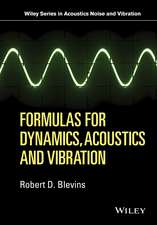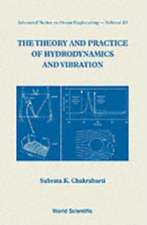Nonlinear Dynamics of Structures: Lecture Notes on Numerical Methods in Engineering and Sciences
Autor Sergio Olleren Limba Engleză Hardback – 3 iul 2014
This work is intended for graduate engineering students who want to expand their knowledge on the dynamic behavior of structures, specifically in the nonlinear field, by presenting the basis of dynamic balance in non‐linear behavior structures due to the material and kinematics mechanical effects.
Particularly, this publication shows the solution of the equation of dynamic equilibrium for structure with nonlinear time‐independent materials (plasticity, damage and frequencies evolution), as well as those time dependent non‐linear behavior materials (viscoelasticity and viscoplasticity). The convergence conditions for the non‐linear dynamic structure solution are studied and the theoretical concepts and its programming algorithms are presented.
| Toate formatele și edițiile | Preț | Express |
|---|---|---|
| Paperback (1) | 390.63 lei 6-8 săpt. | |
| Springer International Publishing – 21 sep 2016 | 390.63 lei 6-8 săpt. | |
| Hardback (1) | 392.60 lei 3-5 săpt. | |
| Springer International Publishing – 3 iul 2014 | 392.60 lei 3-5 săpt. |
Preț: 392.60 lei
Nou
Puncte Express: 589
Preț estimativ în valută:
75.12€ • 78.43$ • 62.17£
75.12€ • 78.43$ • 62.17£
Carte disponibilă
Livrare economică 15-29 martie
Preluare comenzi: 021 569.72.76
Specificații
ISBN-13: 9783319051932
ISBN-10: 3319051938
Pagini: 192
Ilustrații: XII, 192 p.
Dimensiuni: 210 x 297 x 15 mm
Greutate: 0.52 kg
Ediția:2015
Editura: Springer International Publishing
Colecția Springer
Seria Lecture Notes on Numerical Methods in Engineering and Sciences
Locul publicării:Cham, Switzerland
ISBN-10: 3319051938
Pagini: 192
Ilustrații: XII, 192 p.
Dimensiuni: 210 x 297 x 15 mm
Greutate: 0.52 kg
Ediția:2015
Editura: Springer International Publishing
Colecția Springer
Seria Lecture Notes on Numerical Methods in Engineering and Sciences
Locul publicării:Cham, Switzerland
Public țintă
ResearchCuprins
Introduction.- Thermodynamic Basis of the Motion Equation.- Introduction.- Kinematics of the Deformable Bodies.- Basic definitions of tensors describing the kinematics of a point in the space.- Strain Measurements.- Mechanical variables relations.- The Objective Derivative.- Velocity.- Stress Measurements.- Thermodynamics Basis.- First Law of Thermodynamics.- Second Law of Thermodynamics.- Lagrangian local form of Mechanical Dissipation.- Internal Variables.- Dynamic Equilibrium Equation for a Discrete Solid.- Different types of Nonlinear Dynamic Problems.- Materials.Nonlinearity.- Solution of the Motion Equation.- Introduction.- Explicit-implicit solution.- Implicit solution.- Equilibrium at time (t + Δt).- Equilibrium solution in time –implicit methods.- Newmark´s procedure.- Houbolt´s procedure.- Solution of the nonlinear-equilibrium equations system.- Newton-Raphson Method.- Modified Newton-Raphson Method.- Convergence accelerators.- Aitken accelerator or extrapolation algorithm.-B.F.G.S Algorithms.- Secant-Newton algorithms.- “Line-Search”algorithms.- Solution control algorithms – “Arc-Length”.- Ecuación de control de desplazamiento – Superficie esférica.- Convergence Analysis of the dynamic solution.- Introduction.- Reduction to the linear elastic problem.- Solution of second-order linear symmetric systems.- The dynamic equilibrium equation and its convergence-consistency and stability.- Solution stability of second –order linear symmetric systems.- Stability analysis procedure.- Determination of A and L for “Newmark”.- Determination of A and L for central differences- Newmark´s explicit form.- Solution stability of second-order non-linear symmetric systems.- Stability of the linearized equation.- Energy conservation algorithms.- APPENDIX - 1.- APPENDIX - 2.- Time-independent models.- Introduction.- Elastic behavior.- Invariant of the tensors.- Non-linear Elasticity.- Introduction.- Non-linear hyper-elastic model.- Stress based hyper-elastic model.- StabilityPostulates.- Plasticity in small deformations.- Introduction.- Discontinuity behavior or plastic yield criterion.- Elasto-Plastic behavior.- Levy-Mises theory.- Prandtl-Reus theory.- The classic plasticity theory.- Plastic unit or Specific work.- Plastic loading surface. Plastic hardening variable.- Isotropic hardening.- Kinematic hardening.- Stress-Strain relation. Plastic consistency and Tangent rigidity.- Drucker´s stability postulate and maximum plastic dissipation.- Stability condition.- Local stability.- Global stability.- Condition of Unicity of Solution.- Kuhn-Tucker. Loading-unloading condition.- Yield or plastic discontinuity classic criteria.- Rankine criterion of maximum tension stress.- Tresca criterion of maximum shear stress.- Von Mises criterion of octahedral shear stress.- Mohr-Coulomb criterion of octahedral shear stress.- Drucker-Prager criterion.- Geomaterials plasticity.- Basis of the plastic-damage model.- Mechanical behavior required for the constitutive model formulation.- Some characteristics of the plastic damage model.- Main variables of the plastic-damage model.- Definition of the plastic damage variable.- Definition of the law of evolution of cohesion c -κp.- Definition of the variable φ internal friction angle.- Variable definition ψ, dilatancy angle.- Generalization of the damage model with stiffness degradation.- Introduction.- Elasto-plastic constitutive equation with stiffness degradation.- Tangent constitutive equation for stiffness degradation processes.- Particular yield functions.- Mohr-Coulomb modified function.- Drucker-Prager Modified function.- Isotropic Continuous Damage – Introduction.- Isotropic damage model.- Helmholtz´s free energy and constitutive equation.- Damage threshold criterion.- Evolution law of the internal damage variable.- Constritutive tensor of tangent damage.- Particularization of the damage criterion.- General Softening.- Exponential softening.- Linear softening.- Particularization of the stress threshold function.- Simo -Ju. Model.- Setting of A parameter for Simo-Ju. Model.- Lemaitre and Mazars Model.- General model for different damage surfaces.- Setting of A parameter.- Time-dependent Models.- Introduction.- Constitutive equations based on spring-damping analogies.- Kelvin simplified model.- Maxwell simplified model.- Kelvin generalized model.- Kelvin multiple generalized model.- Maxwell generalized model.- Maxwell multiple generalized model.- Dissipation Evaluation.- Multiaxial generalization of the viscoelastic constitutive laws.- Multiaxial form of viscoelastic models.- Numerical solution of the integral and algorithms.- Kelvin model in dynamic problems.- Kelvin model dissipation.- Equation of the dynamic equilibrium for Kelvin model.- Stress considerations. Rayleigh vs. Kelvin model.- Dissipation considerations. Rayleigh vs. Kelvin model.- Cantilever beam.- Frame with rigid beam and lumped mass.- Viscoplasticity.- Limit states of viscoplasticity.- Over stress function.- Integration algorithm for the viscoplastic constitutive equation.- Particular case of the Duvaut-Lyon model a Von Mises viscoplastic material.
Notă biografică
Sergio Oller was appointed Full Professor at the School of Civil Engineering of the Technical University of Catalonia, Barcelona, Spain in 1988, and has worked there, as well as at the International Center for Numerical Methods in Engineering (CIMNE), up to the present.
He has also been Visiting Professor at the Civil Engineering Laboratory of the National University of Tucumán, Argentina, and at the Department of Civil and Environmental Engineering of the University of California at Berkeley, USA.
Oller teaches “Strength of Materials and Structures”, a course in Civil Engineering, Geologic Engineering and Aeronautical Engineering; “Fracture Mechanics”, a course in Numerical Methods in Engineering, and “Composite Materials” and “Non-linear Dynamics” courses in the Doctoral Program in Structural Engineering.
His research fields include: New Structural Materials, Industrial Casting Processes, Parallel Computing, Constitutive Models, Composites Materials, Fatigue, Earthquake Engineering and Dynamic of Structures.
His research fields include: New Structural Materials, Industrial Casting Processes, Parallel Computing, Constitutive Models, Composites Materials, Fatigue, Earthquake Engineering and Dynamic of Structures.
He has also been Visiting Professor at the Civil Engineering Laboratory of the National University of Tucumán, Argentina, and at the Department of Civil and Environmental Engineering of the University of California at Berkeley, USA.
Oller teaches “Strength of Materials and Structures”, a course in Civil Engineering, Geologic Engineering and Aeronautical Engineering; “Fracture Mechanics”, a course in Numerical Methods in Engineering, and “Composite Materials” and “Non-linear Dynamics” courses in the Doctoral Program in Structural Engineering.
His research fields include: New Structural Materials, Industrial Casting Processes, Parallel Computing, Constitutive Models, Composites Materials, Fatigue, Earthquake Engineering and Dynamic of Structures.
His research fields include: New Structural Materials, Industrial Casting Processes, Parallel Computing, Constitutive Models, Composites Materials, Fatigue, Earthquake Engineering and Dynamic of Structures.
Textul de pe ultima copertă
This book lays the foundation of knowledge that will allow a better understanding of nonlinear phenomena that occur in structural dynamics.
This work is intended for graduate engineering students who want to expand their knowledge on the dynamic behavior of structures, specifically in the nonlinear field, by presenting the basis of dynamic balance in non‐linear behavior structures due to the material and kinematics mechanical effects.
Particularly, this publication shows the solution of the equation of dynamic equilibrium for structure with nonlinear time‐independent materials (plasticity, damage and frequencies evolution), as well as those time dependent non‐linear behavior materials (viscoelasticity and viscoplasticity). The convergence conditions for the non‐linear dynamic structure solution are studied, and the theoretical concepts and its programming algorithms are presented.
This work is intended for graduate engineering students who want to expand their knowledge on the dynamic behavior of structures, specifically in the nonlinear field, by presenting the basis of dynamic balance in non‐linear behavior structures due to the material and kinematics mechanical effects.
Particularly, this publication shows the solution of the equation of dynamic equilibrium for structure with nonlinear time‐independent materials (plasticity, damage and frequencies evolution), as well as those time dependent non‐linear behavior materials (viscoelasticity and viscoplasticity). The convergence conditions for the non‐linear dynamic structure solution are studied, and the theoretical concepts and its programming algorithms are presented.
Caracteristici
Presents a complete analysis of the nonlinear behavior of a structure Includes a detailed description of various constitutive models, dependent and independent of time and its influence on the nonlinear behavior of the structure Studies stability and convergence of numerical algorithms which are commonly used in solving the temporary problem of a structure under nonlinear behavior























